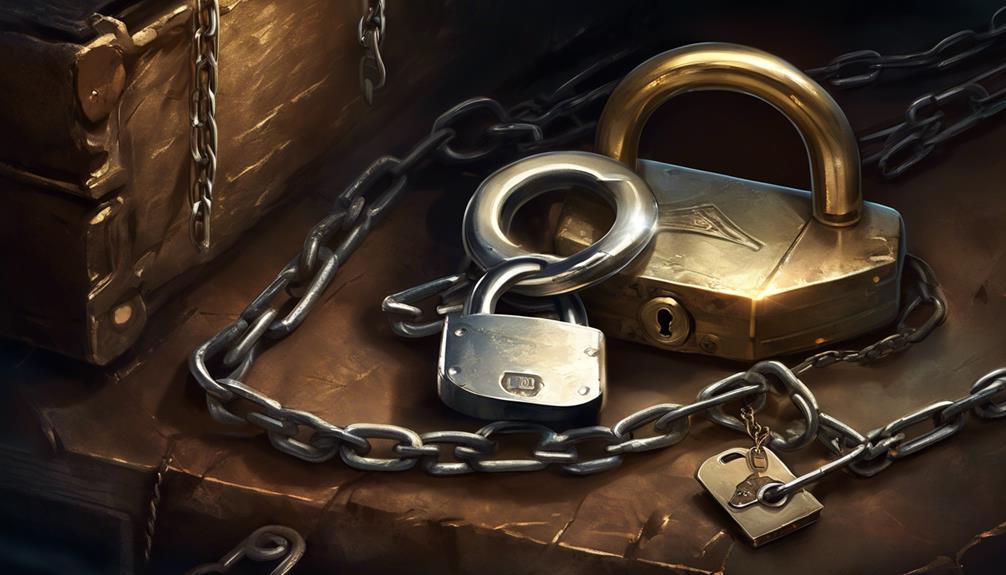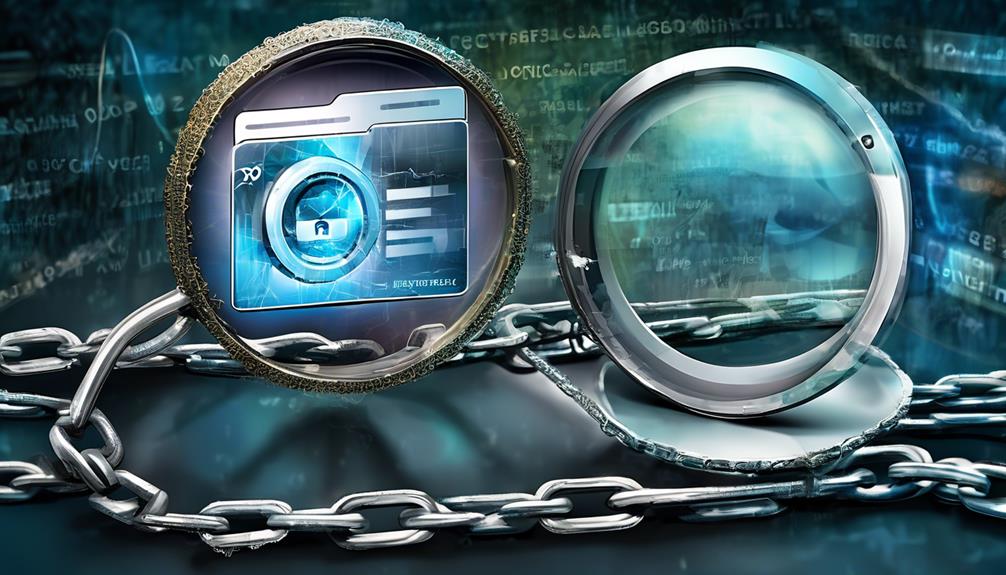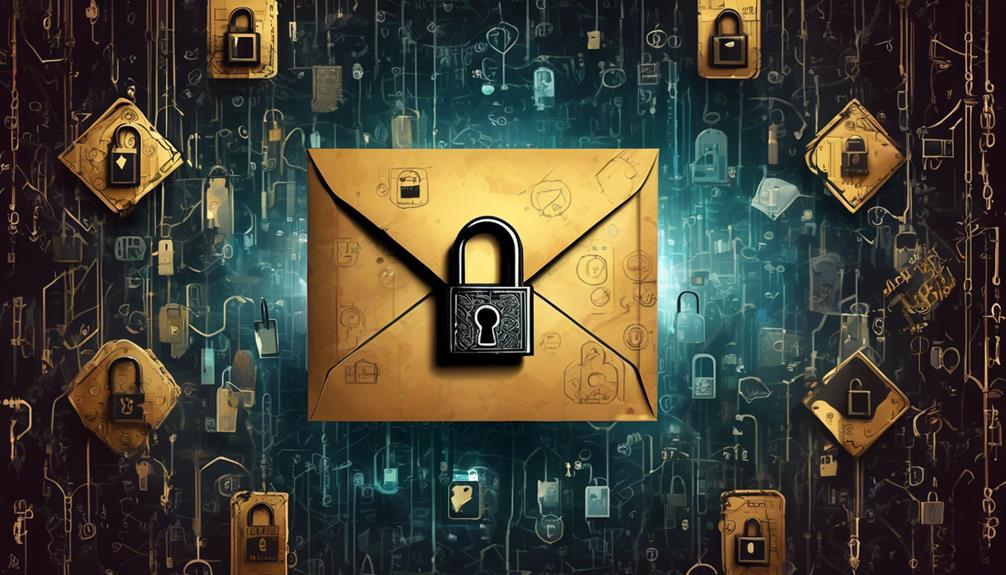In the vast internet landscape, it's crucial to know which email links are safe. Users face many messages with clickable links. However, not all links are the same. Some come from trusted senders and use secure protocols. Meanwhile, others are the work of cybercriminals in disguise. The savvy internet user must differentiate these links. Recognizing safe links often involves noticing small details and assessing the sender's credibility.
Personal data and digital security are constantly at risk. This raises questions about secure versus deceptive links. We will delve into the factors that make some email links safer. Understanding these will help you navigate confidently.
Understanding Email Link Security

Navigating the complexities of email link security requires a thorough understanding of the various threats and the mechanisms by which they operate. Cyber adversaries often employ deceptive practices such as link cloaking, where a malicious URL is disguised as a benign one, to bypass users' vigilance and security measures. This technique exploits trust, leading individuals to inadvertently click on links that can result in malware infections or data breaches.
Attachment safety is another critical facet of email security. Users must scrutinize every attachment, recognizing that file extensions can be spoofed and that even seemingly harmless documents may harbor malicious code. It's essential for community members to not only rely on antivirus software but also to be discerning about the sources of their downloads.
The collective effort to educate on safe email practices establishes a sense of belonging among users, fostering a shared responsibility towards cybersecurity. As individuals become more technically proficient in identifying and mitigating threats, they contribute to a more secure digital environment. This empowers each member of the digital community to protect not just themselves, but also their peers, from the ever-evolving landscape of email-based threats.
Recognizing Trusted Senders
Understanding email security is crucial, but recognizing trusted senders is equally vital. Sender authentication is key, acting as a gatekeeper for email legitimacy. Trusted senders use authentication protocols like DKIM, SPF, and DMARC. These protocols verify their identity, greatly reducing phishing and spoofing risks.
In the realm of email safety, digital signatures add security. These encrypted signatures confirm an email's authenticity and origin. Recognizing valid email signatures, online community members feel more secure. They trust that they are interacting with verified individuals or organizations.
Users should carefully check emails for authentic sender credentials and valid signatures. By doing this, they play a crucial role in their own protection. They also strengthen the collective defense against cyber threats. As individuals learn to identify trusted senders, they help create a more secure digital space for all.
Analyzing Link Structure

Examining the structure of a hyperlink is essential, as it can reveal potential security threats hidden within seemingly innocuous URLs. A meticulously detailed analysis identifies whether a link leads to a legitimate domain or a malicious site masquerading as a trusted entity. Domain legitimacy is a cornerstone of hyperlink security. It involves verifying that the domain name matches the expected destination and isn't a cleverly disguised imitation—a tactic known as phishing.
In this pursuit, experts scrutinize the URL's syntax for discrepancies, such as misleading subdomains or incongruent top-level domains. For instance, a URL claiming to be from a reputable bank but ending in an unusual domain suffix should raise red flags. Moreover, URL shorteners, while convenient, further complicate security assessments. These services condense URLs into a compact form, which can obscure the final destination, making it easier for cybercriminals to hide the true nature of a link.
The community recognizes the importance of being vigilant when clicking on shortened links, and they're encouraged to use tools that preview the full URL before proceeding. This precaution ensures they're not unwittingly stepping into a digital trap. Through collective awareness and rigorous link structure analysis, the group fortifies its defenses against deceptive online threats.
Importance of Secure Protocols
Secure protocols are vital for protecting data in email links. They use HTTPS encryption, which guarantees confidentiality. This prevents unauthorized interception, ensuring data integrity. In contrast, HTTP links increase security risks. These risks include data breaches and man-in-the-middle attacks, which are significant threats.
Understanding HTTPS Encryption
HTTPS encryption serves as the backbone of secure internet communication, ensuring that data transferred between a user's browser and a website remains private and unaltered by unauthorized parties. This secure protocol employs a combination of secure sockets layer (SSL) and transport layer security (TLS) to establish an encrypted link between a web server and a browser. The role of certificate authorities is critical, as they issue digital certificates that verify a website's identity, fostering a sense of trust and community among users.
Here's how HTTPS encryption enhances email link safety:
- Confidentiality: It prevents sensitive information from being intercepted by encrypting data in transit.
- Integrity: It ensures the data isn't tampered with, maintaining its original state.
- Authentication: It verifies the legitimacy of the website, confirming that users are connecting to the actual intended site.
Email Link Verification
While HTTPS encryption is crucial for safeguarding data, verifying the authenticity of email links through secure protocols is equally essential to protect users from phishing and other malicious activities. Link previewers are instrumental in this process, offering a glimpse of the destination URL without direct engagement. These tools scrutinize links against known malicious databases and apply heuristics to ascertain their safety. Meanwhile, URL shorteners complicate verification efforts, as they obscure the final destination, presenting a challenge to traditional security measures. Thus, users belong to a community that must be astute in recognizing the potential risks associated with shortened links. Secure protocols demand a combination of advanced technologies and user vigilance to ensure that the simplicity of clicking an email link doesn't lead to compromising one's digital sanctuary.
Risks of HTTP Links
Navigating the web via HTTP links poses risks, such as eavesdropping and data manipulation. Secure communication protocols are, therefore, essential. HTTP lacks encryption, leading to several issues.
Firstly, there is link obfuscation. Cyber attackers often hide harmful URLs within harmless-looking HTTP links. This makes it hard for users to spot dangers.
Secondly, data interception is a problem. Unencrypted data sent over HTTP can be easily intercepted. This results in privacy violations and the loss of data.
Thirdly, redirection to fraudulent sites is a concern. Users can be unwittingly redirected, a common tactic in phishing to gather private information.
The community desires safer web interactions. Consequently, the tech world stresses the importance of HTTPS. It ensures encryption, upholding the integrity and privacy of user data.
Spotting Phishing Attempts
Phishing attempts often disguise themselves as legitimate communications, requiring a keen eye to discern their malicious intent. Email personalization plays a pivotal role in this deception, luring unsuspecting recipients into a false sense of security. If an email addresses you by your first name or references personal information, it doesn't necessarily mean it's safe. Analyzing the email's content for unsolicited requests or an urgent tone is crucial in spotting a phishing scam.
The technical community is well aware that attachment risks are a significant concern. Phishers frequently use attachments to infiltrate systems with malware. A detail-oriented approach is necessary when examining these files. It's not just the file type that matters, but also the context in which it's sent. One must ask if they were expecting this attachment and whether it's coming from a known and verified sender.
For individuals seeking to protect their digital tribe, it's essential to consider the source of the email. Look past the display name and inspect the actual email address. Often, phishers will use convincing aliases, but the domain name will be a giveaway—a slight misspelling or a deceptive domain should raise red flags. Always approach email links and attachments with a healthy dose of skepticism to maintain the security of the community.
Using Email Security Tools

Using Email Security Tools
To strengthen defenses against complex email threats, individuals and organizations can use advanced security tools. These tools are designed to detect and neutralize risks, ensuring the protection of the system. Email whitelisting and scanning of attachments are key, allowing only trusted sources to reach inboxes and verifying that attached files are clean.
Here are three key aspects of email security tools that improve link safety:
- Real-Time Link Analysis: These tools examine links in emails as they arrive, using known threat databases. Additionally, they conduct behavioral analyses, promptly flagging or blocking harmful links.
- Email Whitelisting: In this process, users create a list of safe senders, which aids security systems. Consequently, these systems can easily identify and permit secure communications, while intercepting emails from unknown sources.
- Attachment Scanning: To inspect email attachments, these tools use sophisticated scanning algorithms. They scrutinize file contents for irregularities, known malware signatures, or odd patterns that might signal an emerging threat.
Best Practices for Clicking Links
When assessing email link safety, users must scrutinize the sender's identity first. Ensure it's not a masquerade by a malicious actor. Additionally, they should examine the URL. Look for signs of security, such as 'https' instead of 'http'. Furthermore, recognizing secure URLs involves looking for digital certificates. Also, understanding the link structure is crucial. This helps identify discrepancies signaling a potential phishing attempt.
Verify Sender Identity
Before clicking an email link, it's vital to verify the sender's identity. This ensures the message is authentic and not a phishing scam. Sender verification is key to maintaining community security. To confirm a sender's identity, follow these steps:
Firstly, inspect the email address closely. Look past the display name and check the actual address for oddities or strange domains.
Secondly, search for digital signatures. Such signatures guarantee the email's integrity and affirm the sender's identity.
Lastly, if in doubt, contact the sender directly. Use established, separate channels to confirm the email's legitimacy.
Recognize Secure URLs
Identifying secure URLs is crucial for protecting oneself against malicious links and maintaining online safety. Users must scrutinize link coloration, which often indicates whether a link has been visited. However, this feature can be manipulated, so reliance solely on coloration is insufficient. A more technical aspect involves examining the URL's structure. Secure links typically begin with 'https://' indicating encryption, while 'http://' lacks this security feature. Domain familiarity also plays a pivotal role; users feel a sense of belonging when interacting with well-known domains, which enhances trust. However, this trust can be exploited through look-alike domains. Therefore, it's essential to verify that the domain exactly matches the expected URL and to be wary of subtle misspellings or unusual domain endings that might signal a phishing attempt.
Frequently Asked Questions
How Do Email Security Measures Impact Email Marketing Campaigns and Click-Through Rates?
Security measures in emails may dissuade recipients, leading to lower click-through rates. Conversely, personalization in emails can enhance engagement. This approach nurtures a feeling of inclusion. Consequently, it helps alleviate security worries in marketing campaigns.
Can Custom Email Domains Inherently Improve the Security of the Links Sent From Them?
Custom email domains may increase link security, thereby improving domain reputation. Additionally, they enforce strict security protocols. This fosters trust among users, who are increasingly cautious regarding their online safety.
Are There Legal Implications for Businesses That Send Out Emails With Insecure Links?
Companies encounter compliance issues and risk lawsuits by sending insecure email links. This breaches data protection duties and could violate customer trust. Additionally, it disregards community security norms.
How Does the Use of URL Shorteners Affect the Security Assessment of Email Links?
He's revealing an additional risk layer. Specifically, URL shorteners in emails conceal the destination. Consequently, this elevates shortener risks and issues with clarity. Moreover, such practice complicates security evaluations. It leaves users uncertain about the link's true nature.
What Role Does Machine Learning Play in the Future Development of Email Link Security?
Predictive analytics is utilized by machine learning algorithms to bolster email link security. Consequently, they identify threats preemptively, shielding users from potential harm. This approach nurtures a digital community perceived as safer. It ensures inclusivity and defense against cyber threats for all members.
Conclusion
In the digital world, dangers lurk from phishing predators. The wise internet user examines each email link meticulously. Like a bomb squad, they approach with caution. Secure protocols serve as their shield against threats. They also use email security tools as protective gear. This arsenal of technology aids their safe navigation. Paranoia and skill are their guiding principles. Remember, the cautious are the ones who thrive online. Otherwise, you might meet a hacker – not a pleasant experience.



